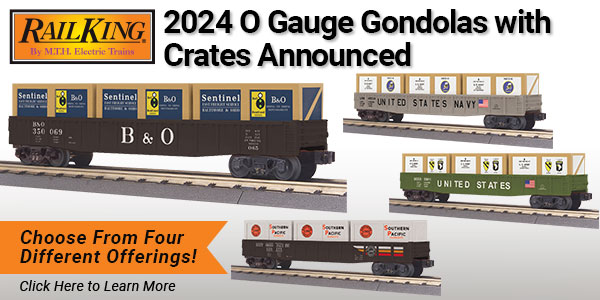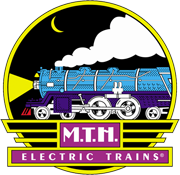
April 9, 2024 - M.T.H. Electric Trains will be releasing the 2024 RailKing O Gauge Gondola Car w/Crates in four different schemes this Fall. Each of these offerings is expected to begin shipping to M.T.H. Authorized Retailers in October 2024.
Check out each of the offerings in the list on the left.
PROTOTYPE HISTORY
On its customer Web site, the Union Pacific Railroad characterizes a gondola as an “extremely sturdy open design” for carrying “rugged unfinished commodities”; its “large flat interior design with side walls” is described as “more flexible than a flat car.” These qualities make the modern gondola particularly popular with the steel industry, for transportation of loose materials like scrap metal, waste, coke, and slag as well as finished products like iron or steel plate, pipe, structural steel, and rails for railroad track. Other commodities commonly shipped in these versatile cars include mineral ores, granite slabs, gravel, logs, lumber, railroad ties, and even prefabricated railroad track, also known as “panel track.”
Until the advent of specialized coil cars in the 1960s, another popular load for gondolas was coiled sheet metal, usually steel, on its way from mills to manufacturers of stamped metal items from car parts to appliances. As depicted on this model, specialized covers — similar to the covers later used on dedicated coil cars — protected the raw metal from the elements during transit. Brackets on the covers provided a lifting point for an overhead crane and also allowed the covers to be stacked on top of each other when not in use.
The name “gondola” actually predates railroads. In the early 1800s, utilitarian flat-bottomed boats with low sides, used to transport coal down the Potomac River to the Washington D.C. area, were called gondolas as a spoof on the much fancier Venetian gondolas. Similarly shaped coal-carrying cars on early railroads earned the same moniker. As more specialized cars were invented for coal service, the gondola evolved into the general-purpose car it is today.
Check out each of the offerings in the list on the left.
Product Features
- Intricately Detailed Durable ABS Body
- Metal Wheels and Axles
- Die-Cast 4-Wheel Trucks
- Operating Die-Cast Metal Couplers
- Colorful, Attractive Paint Schemes
- Decorative Brake Wheels
- Fast-Angle Wheel Sets
- Needle-Point Axles
- (3) Removable Crates
- Unit Measures: 11 15/16 x 2 3/16 x 1 11/16
- Operates On O-27 Curves










